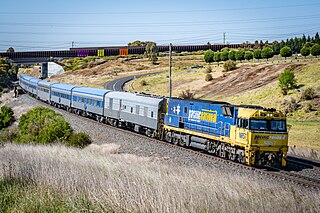
The Overland is an interstate passenger train service in Australia, travelling between the state capitals of Melbourne and Adelaide, a distance of 828 km (515 mi). It first ran in 1887 as the Adelaide Express, known by South Australians as the Melbourne Express. It was given its current name in 1936. Now operated by private company Journey Beyond, the train undertakes two return trips a week. Originally an overnight train that stopped at large intermediate stations, it now operates during the day, stopping less frequently.

The Australian National Railways Commission was an agency of the Government of Australia that was a railway operator between 1975 and 1998. It traded as Australian National Railways (ANR) in its early years, before being rebranded as Australian National. AN was widely used from 1980, the logotype being registered as a trade mark.
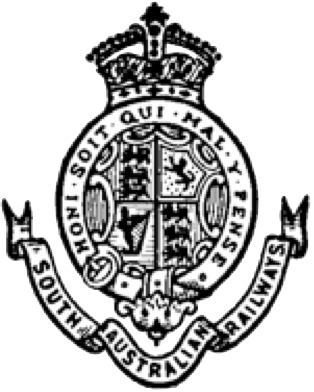
South Australian Railways (SAR) was the statutory corporation through which the Government of South Australia built and operated railways in South Australia from 1854 until March 1978, when its non-urban railways were incorporated into Australian National, and its Adelaide urban lines were transferred to the State Transport Authority.
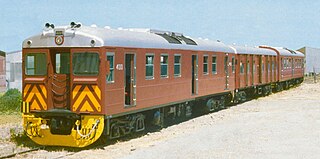
The Redhen railcars was the nickname given to the 300 and 400 classes of diesel-hydraulic railcars designed by the South Australian Railways and built at its Islington Railway Workshops between 1955 and 1971. The railcars, which operated in Adelaide suburban service until 1996, remain a nostalgic part of South Australian memory. Some continue to be operated by the SteamRanger Heritage Railway, the National Railway Museum, Port Adelaide and other railway preservation entities.

East Coast Heritage Rail is a not for profit company limited by guarantee formed in June 1985 as 3801 Limited to operate steam locomotive 3801 and its associated rolling stock. The company operated heritage train tours from 1986 until 2017, with operations recommencing in February 2019 under the new brand, East Coast Heritage Rail.

The 2000 class and 2100 class were diesel multiple units that operated on the Adelaide rail network between 1980 and 2015. They were built by Comeng in Granville, New South Wales in 1979–1980. As of 2024, six railcars have been preserved while the rest have been scrapped.

The 81 class are a class of diesel locomotives built by Clyde Engineering, Kelso for the State Rail Authority.

The National Railway Museum, Port Adelaide, South Australia is the largest under-cover railway museum in Australia. More than 100 major exhibits, mainly from the South Australian Railways (SAR) and Commonwealth Railways and their successor, Australian National, are displayed at its 3.5 hectares site. A large archival collection of photographs of those railways and records created by them is also managed by the museum. The museum operates with a large number of volunteers.
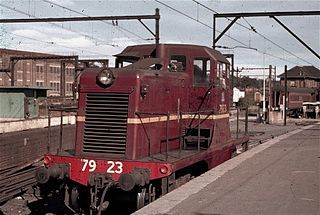
The 79 class is a diesel-electric locomotive built by General Electric, Erie, United States for the Department of Railways New South Wales in 1943.
The South Australian Railways 400 class comprised ten 4-8-2+2-8-4 articulated steam locomotives built in France in 1952 and 1953 under licence to Beyer, Peacock & Co. Ltd, Manchester, UK. The locomotives mainly hauled ore on the 1067 mm narrow-gauge line from the New South Wales/South Australia border to smelters at Port Pirie until 1963, when they were replaced by diesel locomotives. They also operated on the line to the break-of-gauge station at Terowie. Some locomotives were returned to service in 1969 while narrow gauge diesel locomotives were converted to 4 ft 8+1⁄2 instandard gauge. Subsequently some were stored at Peterborough before being scrapped.

The Commonwealth Railways NSU class was a class of diesel-electric locomotives built in 1954 and 1955 by the Birmingham Railway Carriage and Wagon Company, England, for the Commonwealth Railways to be deployed on the narrow-gauge Central Australia Railway and North Australia Railway.

The South Australian Railways 930 class was a class of diesel-electric locomotives built for the South Australian Railways between 1955 and 1967 by AE Goodwin, Auburn, New South Wales, the Australian licensee of the American Locomotive Company (Alco). Based on the Alco DL500B World series model, they were fitted with Alco 12-251B four-stroke V12 turbocharged diesel engines that developed 1600 horsepower for traction. The first six of the class had a driving cab at one end only; the remaining 31 locomotives had two. The latter series, up-rated, were the basis of the almost identical New South Wales 44 class, of which 100 were built from 1957.

The 600 class are a class of diesel-electric locomotives manufactured by AE Goodwin, Auburn for the South Australian Railways between 1965 and 1970.

The 500 class were a class of South Australian Railways diesel shunter locomotives built at Islington Railway Workshops between 1964 and 1969.

The South Australian Railways 350 class comprised two diesel-electric locomotives built by the railway's Islington Railway Workshops, entering service in June 1949. They were the first diesel-electric locomotives built in Australia and the first to be operated by the South Australian Railways.

The 900 class were a class of diesel locomotives built by Islington Railway Workshops for the South Australian Railways between 1951 and 1953.
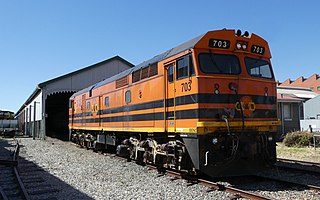
The 700 class is a class of six diesel-electric locomotives based on the Alco DL500G model, built by AE Goodwin, Auburn, New South Wales for the South Australian Railways. They are virtually identical to the New South Wales 442 class locomotive.
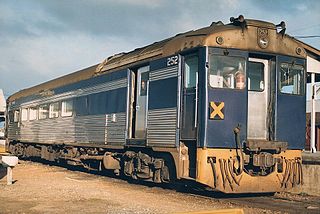
The Bluebird railcars were a class of self-propelled diesel-hydraulic railcar built by the South Australian Railways' Islington Railway Workshops between 1954 and 1959.

The South Australian Railways T class was a class of seventy-eight 1067 mm narrow-gauge 4-8-0 steam locomotives operated by the South Australian Railways. Several were sold to the Tasmanian Government Railways; some others operated on the Commonwealth Railways. Four were converted to operate on 1600 mm broad-gauge lines.

The South Australian Railways 700 class was a class of 2-8-2 steam locomotives operated by the South Australian Railways.



















